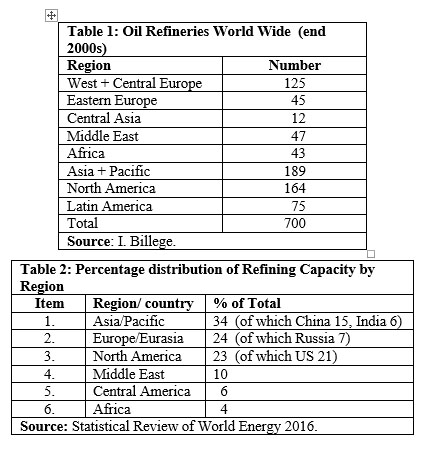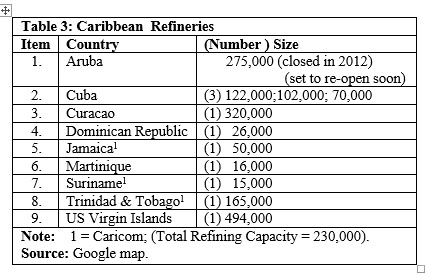Introduction
Today I start my discussion of the fourth and penultimate Guidepost listed in the spending dimension of Guyana’s Petroleum Road Map. For this topic I basically re-state, with some refinements, my earlier advice to the effect that there is no sound economic basis for the Government of Guyana (GoG) to invest a huge portion of its expected petroleum revenues in creating value-added refining to its crude oil exports, given the prevailing global and national environment.
I have already argued this case in rather extensive detail over the long period May 28, 2017 to October 29, 2017. I shall not, therefore, repeat in detail that earlier discussion. Its main outlines are briefly summarised, before I turn to consider next the last Guidepost (5) in the Guyana Petroleum Road Map. My intention remains, as of now, to complete consideration of Guyana’s Petroleum Road Map, before First Oil, due in 2020.
Today’s column starts the discussion by locating the establishment of an oil refinery within its development paradigm and the prevailing global environment.
Development Paradigm
Strong economic nationalists argue that the paradigm to drive Guyana’s development is: “the country should produce all it can produce”. This view holds that Guyana’s oil and gas sector should develop, to the extent and only to the extent that Guyana can achieve this aim. Therefore, local content requirements or policies should be designed to constrain “foreign, ownership, control of decision-making, and management of the oil and gas sector”. A local refinery refining Guyana’s crude oil production is, therefore, the highest expression of Guyana’s autonomous development. Such a self-sufficiency paradigm, minimises the developmental roles of country specialisation, capacitation, comparative costs, the movement of international trade and exchange in goods, services, finance, and productive factors (including capital), as well as natural resources. And, it is indeed the very minimisation of these roles which makes the “paradigm of autarky” unworkable in an increasingly integrated international economy, based on globalised value chains. Today, these value chains are more powerful than even the biggest global economies, where the “USA-China global trade war” testifies to its correctness.
What is an Oil Refinery?
It is useful to begin the discussion by asking the basic question: what is an oil refinery? The standard description is: “an industrial plant that refines crude oil into a multiplicity of petroleum products”. Such a plant adds value to the extraction of Guyana’s crude oil discoveries. From this perspective, establishing an oil refinery in Guyana must be located in a global context, since the petroleum products produced must be sold in markets far larger than Guyana’s, if the refinery is to be commercially feasible. The next question that follows is: What is the state of global oil refining?
Global Refining
Presently, approximately 100 million barrels of crude oil are processed each day. This figure is up by about 14 million barrels per day (b/d), since the mid-2000s. There are approximately 700 oil refineries, worldwide. This number and its distribution are revealed in Tables 1 and 2. To add to this information, it is noted that, at the latest count, as many as 116 countries worldwide have established oil refineries! Their geographic distribution across regions is wide, including also in the Caribbean area.
I cite these data mainly to observe that a local oil refinery cannot be evaluated or assessed in isolation of the global market configura-tion. Readers are, therefore, reminded that the proposed refinery, which the GoG had commissioned in 2017, was designed to add less than 0.1 percent to total global refining capability!
Further, it should be noted also that the top ten oil refineries worldwide have capacities ranging from a low of 0.52 million barrels per day (b/d) to more than double that, 1.24 million b/d. Similarly, the top 10 countries in terms of oil refining capacity range from Canada at number 10 (2.5 million b/d) to the United States, number one, refining more than 18 million b/d.
Finally, the Caribbean refineries data from Google Map are shown in Table 3.
Caribbean (Caricom) Oil Refining
Presently, there are nine Caribbean oil refineries, with three of these located in the Caricom sub-region. Total Caribbean refining capacity is 1.3 mln b/d; and for the Caricom sub-region, 230,000 b/d. Available estimates suggest that only about 60-70 percent of this capacity has been available.
The size/range of Caribbean refineries is from a low of 15,000 b/d in Jamaica to 320,000 b/d in Curacao. Of note, the Aruba refinery, with a capacity of 275,000 b/d was closed in 2012, but there are plans to reopen the complex. There are also plans for a second refinery to be built in Jamaica. Cuba has three refineries, with capacities of 122,102 and 70,000 b/d.
Usually, those Caribbean countries with smaller refineries focus on domestic markets, while those with larger refineries focus on exporting. Further, some analysts argue the region’s unique island location and proximity to global transportation routes, offer much scope for expansion of export-based oil refining!
Conclusion
Next week I shall address the crucial observation that: no two oil refineries are the same. This is illustrated in the wide variation in refining sizes cited above. However, as I shall observe next week, the more significant variation is in refinery capabilities.











